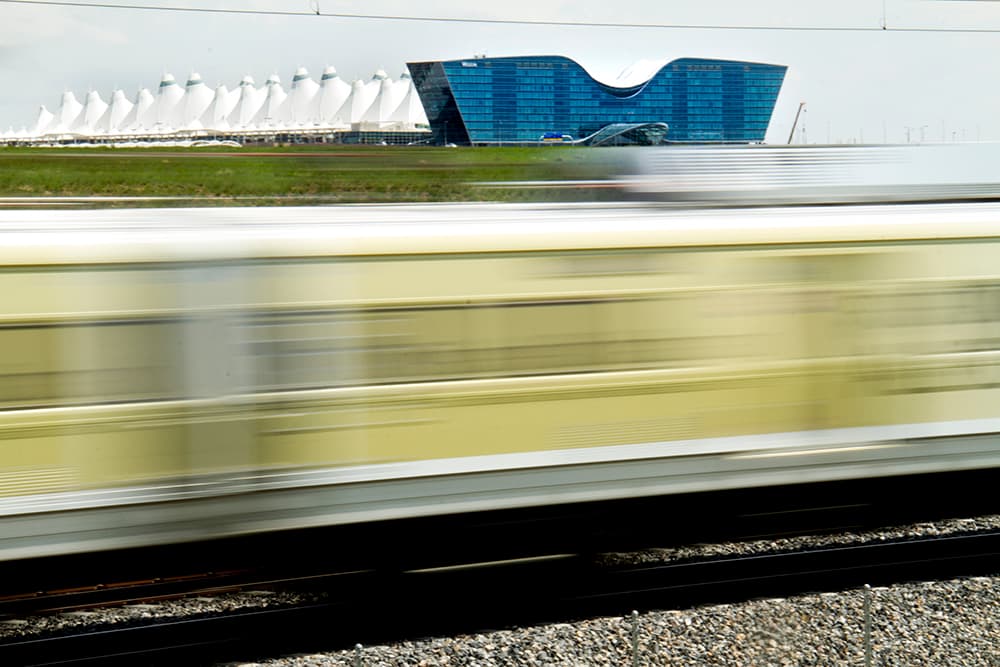
Denver Mayor Michael Hancock will give his annual state of the city address today at 11 a.m. in the Plaza @ DEN in front of the new Westin Hotel at Denver International Airport.
The address is open to the public, but the location has drawn criticism. It's $9 to take the train to the airport and certainly more if you drive and park. Previous State of the City addresses were in more accessible locations like the Denver Art Museum or the Denver Museum of Nature and Science.
Activists will hold a "People's State of the City" event at 3 p.m. today in front of the City and County Building, 1437 Bannock St. Meanwhile, in Civic Center Park, activists from Black Lives Matter 5280 continue their 135-hour vigil against police violence.
"Aerotropolis"
The location of today's address is meaningful as Hancock has made development at and around the airport a centerpiece of his administration. He called for the creation of an "aerotropolis" at in his first inaugural address in 2011 and linked it to the idea of a "Corridor of Opportunity." He has delivered a progress report on the airport train and the airport hotel in ever state of the city since and his second inaugural address last year.
Here is Hancock in 2012:
We’re also tapping the boundless potential of our $22 billion-a-year international airport. Progress is well underway on the South Terminal hotel project and the FasTracks East Rail line, which will create a vital transportation link between DIA and Downtown Denver. ... And together with our regional partners, we’re beginning to plan an Aerotropolis around the airport. If we do this right, and by right I mean smart, we will spur a new frontier of economic growth that will transform metro Denver. Developing the land inside the airport grounds will net us more than 30,000 additional jobs in the next 20 years. And the potential for new job growth outside those boundaries is staggering.
In 2013:
Soon, FasTracks will connect us all to our international airport. This will light-up development along the 20-mile route, an area you might have heard me call the Corridor of Opportunity and Aerotropolis.
In 2014:
We expect the Corridor of Opportunity between DIA and downtown to have a $2.6 billion impact on our economy and provide 40,000 new jobs over the next three decades. At DIA, the windows are up on 12 of the 14 floors of the new hotel and transit center, reflecting not only the profile of the airport but the strides we are making toward expanding our gateway to the world.
And in 2015:
We are just scratching the surface of possibilities that development at the airport brings. I am pumped to get the new hotel open in November and begin train service from the airport to Denver Union Station in the spring. By leveraging these strengths, we brought the new U.S. Patent and Trademark Office to Denver. By leveraging these strengths, we have established a global partnership with United Airlines. By leveraging these strengths, Panasonic is building a hub of innovation and smart living at 61st and Peña, the likes of which have never been seen before. And we are not stopping there.
Now, the train is running, the city is moving forward with plans for transit-oriented development along the A Line and voters in Denver and Adams County overwhelmingly passed a measure to allow the development of non-aviation businesses within airport grounds.

The boosterism that Hancock displays toward the airport extends to downtown, to the redevelopment in north Denver of the National Western Center, to the building boom that is transforming the city. In the mayor's view, all of Denver benefits from the jobs that all this development brings.
Gentrification
But Hancock is speaking this year amid a feeling of crisis around gentrification and housing affordability. This concern is not new and has only increased with the number of cranes and "we flip houses" signs sprouting around the city.
Hancock in 2013:
I have the audacity to believe that anyone who wants to live in the city should not be forced out because of cost. Yet 25,000 families in Denver need more affordable options. ...
Denver’s Inclusionary Housing Ordinance has failed. Its unbalanced requirement of developers to provide affordable units is plagued with loopholes and inconsistencies. To sincerely address this housing gap, we need to build, rehab and preserve at least 600 units per year for the next five years. But we can’t do this alone. I am asking local nonprofits, private sector developers and the financial community to help the city deliver on the goal of three by five: Three thousand workforce units in the next five years.
In 2014:
Soon, we will release a Denver Housing Plan that will provide a comprehensive path forward for the city’s housing policies and resource allocations over the next five years. By being crystal clear in communicating our intentions to keep Denver affordable, we are taking a proactive approach to making substantive change.
In 2015:
In the months ahead, we will refine a plan to generate at least $15 million every year to produce nearly 6,000 units of affordable housing. In addition, we intend to move forward with other strategies to produce, protect and rehabilitate affordable housing in Denver – everything from modifying the affordable housing preservation ordinance to providing tax and fee relief to developers of affordable and mixed income housing. We hear you, we stand with you and we will create possibilities together.
It has not escaped the notice of housing advocates and community activists that progress toward this new housing plan is slower than development at the airport and the resources devoted to it much less than those put toward the National Western.
However, the city is moving forward with a new dedicated funding source for affordable housing. More details are expected this week.
We'll be at the State of the City address today as well as the people's response and we'll bring you updates throughout the day about where the mayor sees his priorities and what activists would like to see instead.












